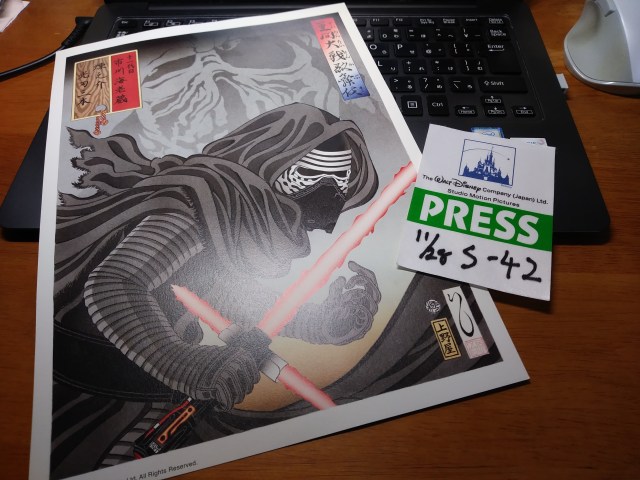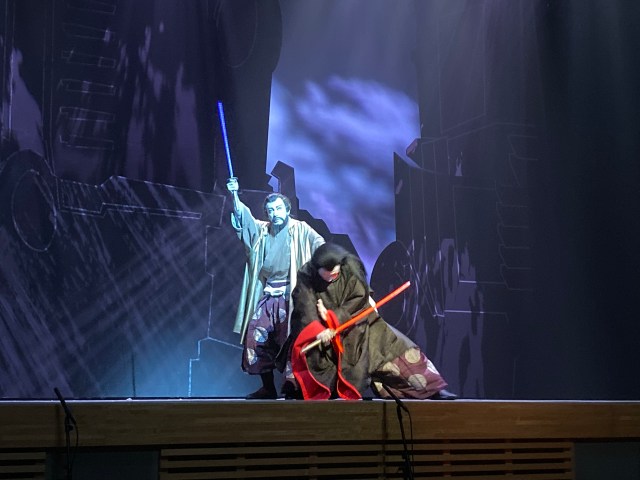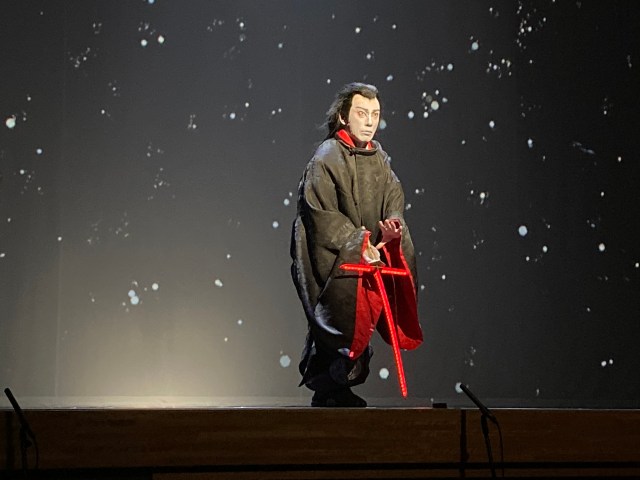
Japan’s biggest kabuki star becomes Kylo Ren, and here’s how you can watch the performance yourself.
A long, long time ago (last Thursday night) in a galaxy far, far away (the Meguro Persimmon Hall in Tokyo’s Setagaya Ward), the Star Wars saga manifested itself in perhaps its most unexpected form ever. Yes, George Lucas’ landmark 1977 film, retroactively subtitled A New Hope, has inspired cinematic sequels, TV specials, animated spin-offs, novels, comic books, video games, but it wasn’t until November 28 that there was a Star Wars kabuki play.
The announcement of the production was both sudden and surprising, coming just a little more than three weeks before the curtain rose, but this was defintiely something we were clearing out our schedule to attend.
And make no mistake, this was no cut-rate, slap-dash parody of Japan’s most celebrated stage tradition. The producers went so far as to recruit the one and only Ichikawa Ebizo, Japan’s most popular and celebrated kabuki actor working today, for the lead role of Kylo Ren in Star Wars Kabuki-Kairennosuke and the Three Shining Swords.
▼ Ichikawa Ebizo and his six-year-old son Shinnosuke (who also appears in the play) meet BB-8, R2-D2, and C-3PO.
Actually, it’s not entirely accurate to say that the producers recruited Ebizo, since the 41-year-old actor, speaking to the audience before the start of the play, explained that for some time he’s been having his agent let it be known that he’d be very interested in an artistic collaboration with the Star Wars franchise, since he’s long been a fan himself. “My favorites are the original trilogy,” he says. “I like how the picture is still a little fuzzy, and not too sharp.” He also revealed a surprising choice for his personal favorite character. “I like Jar Jar. Iyasaremasu. There’s just something I like about him.”
However, it’s Star Wars‘ weightier themes that really capture Ebizo’s imagination. “I like the conflict between the Jedi and the Dark Side of the Force. In kabuki too, there are many stories of good and evil opposing each other, and it’s interesting to see how even good Jedi can be pulled towards the Dark Side by fear and worry.”
Prior to the start of the show, a group of Buddhist monks performed a ceremony asking for the success and safety of the crews for both the Star Wars kabuki play and the upcoming Rise of Skywalker movie. As they chanted sutras and burned incense, they were joined by Ebizo, Shinnosuke (also a kabuki actor, nicknamed “Kankan” by fans), and a representative of Walt Disney Japan, who also offered prayers.
▼ Eibzo on-stage and in costume as Kylo Ren
With so much Star Wars material to draw from, it would be impossible to cover everything in a single stage production, so instead Three Shining Swords focuses on the events of the two most recent Star Wars episodes, The Force Awakens and The Last Jedi. The play was split into three acts: “A Sword to My Father,” “A Sword to My Master,” and “A Sword to My Teacher,” and in order to give a certain classical Japanese ring to them, Star Wars’ heroes and villains had their names slightly altered to:
● Kylo Ren → Kairennosuke 魁連之助
● Luke → Ruku 琉空
● Leia → Reian 澪殷
● Han Solo → Hanzo 半蔵
● Rey → Reina 麗那
● Snoke → Sunokaku 敷能角
● Admiral Holdo → Amiri 愛深理
● Jedi → Judai 壽臺
● First Order → Oda-gun 旺拿軍
The Star Wars kabuki play was a one-night only performance, but the producers have generously made the entire thing, which runs about 30 minutes, available for viewing on YouTube. However, there are no English subtitles, so we’ve got the play-by-play, as well as our impressions, below.
Each act focuses on the internal turmoil Kairennosuke struggles with while drawing his sword in anger to kill and sever the ties to an important figure in his life. Accompanied by traditional kabuki instrumental accompaniment such as drums and shamisen, the audience watched the tragedy as Hanzo, after infiltrating Starkiller Base, fails to turn his son back from the path of evil. Rather than immediately stabbing his father like his movie counterpart, Kairennosuke first attempts to throw the still-alive Hanzo down a pit, and when he sees that his father is clinging to the edge by his fingertips, mercilessly stabs him while looking him straight in the eyes.
A flashy transition of stylized projected animation and laser blasts served as transition to “A Sword to My Master,” which opens with Reian and Amiri (both dressed in the traditional multi-layered kimono of noble ladies) saying a tearful good-bye as Amiri offers to stay behind and sacrifice herself in a suicide attack on the Oda-gun forces pursing them. A shift in scene then reveals Kairennosuke in the throne room of Sunokaku, who has captured Reina and is compelling his conflicted underling to strike her down.
▼ Sunokaku (far right) during his curtain call
Instead, though, Kairennosuke turns his aggression towards Sunokaku, gripping his light saber with his own hands as he slices into his former master, then straddles his prone body and stabs him in the neck to finish him off. Kairennosuke takes on Sunokaku guards by himself, though just like in The Last Jedi Reina is unable to convince him to renounce the Oda-gun and return to the Light Side.
Finally, “A Sword to My Teacher,” drops us into the duel between Kairennosuke and Ruku, fought on the surface of the planet Crait in the shadow of the leg of an AT-AT. In his most challenging scene of the night, Ebizo plays the roles of both combatants, employing some incredibly quick costume-change techniques whenever the fight takes him and his opponent behind debris so that Ebizo is always portraying the character who’s speaking.
Once again mirroring the events of its film counterpart, “A Sword to My Teacher” reaches its emotional climax with a stark juxtaposition of Kairennosuke’s violent desire for change versus Ruku’s gentle acceptance of sorrowful loss, and a final, peaceful moment of the Judai master’s physical body, portrayed by Shinnosuke, just before he expires, alone, on a distant plant from which he’d been projecting his consciousness.
So in the end, does Star Wars work as kabuki? Yeah, it does. Kabuki has always been more about grand, dramatic motion and facial expressions instead of minute subtlety, and so it conveys a strong sense of Kylo Ren’s/Kairennosuke’s inability to keep from trying to change his fate in violent, ill-advised ways.
It’s also nice, for pre-existing Star Wars fans, to have a play with a plot they’re already familiar with. Archaic speech patterns and stylized dialogue deliveries are the norm in kabuki, so much so that even native Japanese speakers often aren’t able to fully comprehend what the actors are saying, but as an adaptation of a modern work, Three Shining Swords allows kabuki newcomers to focus entirely on the visual and audio artistry, appreciating details like how the light sabers are actually light katanas with slight curves (including for the cross-pieces of Kairennosuke’s) , or how Sunokaku’s gold robe actually works pretty well when paired with a pair of billowy hakama pants.
▼ Amiri (left) and Reian (right), with members of Sunokaku’s guard troop behind them
▼ Reina (far right)
While it may or may not make you a kabuki fan, Star Wars Kabuki-Kairennosuke and the Three Shining Swords is something no one who watches it is ever likely to forget, and also just about the most original way ever to do a “the story so far” recap for a movie sequel ever.
Photos ©SoraNews24
● Want to hear about SoraNews24’s latest articles as soon as they’re published? Follow us on Facebook and Twitter!
Follow Casey on Twitter, where he was once scolded by his study abroad adviser for skipping a kabuki play to go to a car show.














 Want tickets to the Star Wars kabuki play? Here’s how you can win a pair for free
Want tickets to the Star Wars kabuki play? Here’s how you can win a pair for free Star Wars is being turned into a kabuki play with one Japan’s biggest stars playing Kylo Ren
Star Wars is being turned into a kabuki play with one Japan’s biggest stars playing Kylo Ren Nausicaa of the Valley of the Wind kabuki play’s rehearsal video is incredible【Video】
Nausicaa of the Valley of the Wind kabuki play’s rehearsal video is incredible【Video】 Final Fantasy X is becoming a kabuki play with actor with anime-to-stage experience
Final Fantasy X is becoming a kabuki play with actor with anime-to-stage experience Rey’s sweet revenge on Kylo Ren at conveyor belt sushi restaurant sets Japanese Twitter abuzz
Rey’s sweet revenge on Kylo Ren at conveyor belt sushi restaurant sets Japanese Twitter abuzz Japan’s new difficult-to-drink-from beer glass protects your liver, but it’s a brutal experience
Japan’s new difficult-to-drink-from beer glass protects your liver, but it’s a brutal experience Demon Slayer: Kimetsu no Yaiba gets new roller coaster attractions and food at Universal Studios Japan
Demon Slayer: Kimetsu no Yaiba gets new roller coaster attractions and food at Universal Studios Japan How to order snacks on a Shinkansen bullet train in Japan
How to order snacks on a Shinkansen bullet train in Japan Burger King Japan suddenly adds Dr. Pepper and Dr. Pepper floats to its menu nationwide
Burger King Japan suddenly adds Dr. Pepper and Dr. Pepper floats to its menu nationwide New Pokémon ice cream, dessert drinks, and cool merch coming to Baskin-Robbins Japan【Pics】
New Pokémon ice cream, dessert drinks, and cool merch coming to Baskin-Robbins Japan【Pics】 Caffeinated ramen for gamers that you can eat with one hand going on sale in Japan
Caffeinated ramen for gamers that you can eat with one hand going on sale in Japan New samurai glasses are Japan’s latest weird must-have souvenir
New samurai glasses are Japan’s latest weird must-have souvenir McDonald’s adds new watermelon frappe and fruity macaron to its menu in Japan
McDonald’s adds new watermelon frappe and fruity macaron to its menu in Japan Princesses, fruits, and blacksmiths: Study reveals the 30 most unusual family names in Japan
Princesses, fruits, and blacksmiths: Study reveals the 30 most unusual family names in Japan We check out the local flavors of the commonly confused Ome and Aomi areas of Tokyo in one day
We check out the local flavors of the commonly confused Ome and Aomi areas of Tokyo in one day Nintendo history you can feel – Super NES, N64, and GameCube controllers become capsule toys
Nintendo history you can feel – Super NES, N64, and GameCube controllers become capsule toys Hello, cosmetics! Clinique teams up with Hello Kitty this summer for first-time collaboration
Hello, cosmetics! Clinique teams up with Hello Kitty this summer for first-time collaboration “The most Delicious Cup Noodle in history” – Japan’s French Cup Noodle wins our heart【Taste test】
“The most Delicious Cup Noodle in history” – Japan’s French Cup Noodle wins our heart【Taste test】 Starbucks releases a cute Frappuccino and Unicorn Cake…but not in Japan
Starbucks releases a cute Frappuccino and Unicorn Cake…but not in Japan Kyoto Tower mascot termination reveals dark side behind cute Japanese characters
Kyoto Tower mascot termination reveals dark side behind cute Japanese characters McDonald’s Japan’s Soft Twist Tower: A phantom ice cream only sold at select branches
McDonald’s Japan’s Soft Twist Tower: A phantom ice cream only sold at select branches Yabai Ramen: What makes this Japanese ramen so dangerous?
Yabai Ramen: What makes this Japanese ramen so dangerous? Finally! Nintendo Japan expands Switch 8-bit controller sales to everybody, Online member or not
Finally! Nintendo Japan expands Switch 8-bit controller sales to everybody, Online member or not Japanese government wants to build luxury resorts in all national parks for foreign tourists
Japanese government wants to build luxury resorts in all national parks for foreign tourists To combat declining birth rate, Japan to begin offering “Breeding Visas” to foreigners
To combat declining birth rate, Japan to begin offering “Breeding Visas” to foreigners 10 things you should buy at 7-Eleven in Japan
10 things you should buy at 7-Eleven in Japan Studio Ghibli releases anime heroine cosplay dresses that are super comfy to wear
Studio Ghibli releases anime heroine cosplay dresses that are super comfy to wear Woman charged for driving suitcase without a license in Osaka
Woman charged for driving suitcase without a license in Osaka Studio Ghibli unveils My Neighbour Totoro miniature house model
Studio Ghibli unveils My Neighbour Totoro miniature house model Kyoto experiencing problems with foreign tourists not paying for bus fares, but not on purpose
Kyoto experiencing problems with foreign tourists not paying for bus fares, but not on purpose Fighting mild hunger with a Japanese soda that turns into jelly in the stomach【Taste test】
Fighting mild hunger with a Japanese soda that turns into jelly in the stomach【Taste test】 Studio Ghibli’s Howl’s Moving Castle tapestry unveiled in Japan for first time
Studio Ghibli’s Howl’s Moving Castle tapestry unveiled in Japan for first time McDonald’s new Happy Meals offer up cute and practical Sanrio lifestyle goods
McDonald’s new Happy Meals offer up cute and practical Sanrio lifestyle goods Sales of Japan’s most convenient train ticket/shopping payment cards suspended indefinitely
Sales of Japan’s most convenient train ticket/shopping payment cards suspended indefinitely Sold-out Studio Ghibli desktop humidifiers are back so Totoro can help you through the dry season
Sold-out Studio Ghibli desktop humidifiers are back so Totoro can help you through the dry season Japanese government to make first change to romanization spelling rules since the 1950s
Japanese government to make first change to romanization spelling rules since the 1950s Foreigner’s request for help in Tokyo makes us sad for the state of society
Foreigner’s request for help in Tokyo makes us sad for the state of society Ghibli founders Toshio Suzuki and Hayao Miyazaki contribute to Japanese whisky Totoro label design
Ghibli founders Toshio Suzuki and Hayao Miyazaki contribute to Japanese whisky Totoro label design Doraemon found buried at sea as scene from 1993 anime becomes real life【Photos】
Doraemon found buried at sea as scene from 1993 anime becomes real life【Photos】 Tokyo’s most famous Starbucks is closed
Tokyo’s most famous Starbucks is closed What Pokémon Type are you? A quick look at your social media habits will give you the answer
What Pokémon Type are you? A quick look at your social media habits will give you the answer An exquisite work of beef art makes the perfect Kabuki Day gift
An exquisite work of beef art makes the perfect Kabuki Day gift J.J. Abrams tells us fan-fav Jedi may make first-ever live-action appearance in Rise of Skywalker
J.J. Abrams tells us fan-fav Jedi may make first-ever live-action appearance in Rise of Skywalker Star Wars cafe to open in Tokyo as part of city’s real-life Star Wars Holiday special events
Star Wars cafe to open in Tokyo as part of city’s real-life Star Wars Holiday special events Hayao Miyazaki’s Nausicaä of the Valley of the Wind set to become live-action Japanese kabuki play
Hayao Miyazaki’s Nausicaä of the Valley of the Wind set to become live-action Japanese kabuki play Casual Jedi cosplay! Japanese fashion brand unveils Star Wars items just in time for new film
Casual Jedi cosplay! Japanese fashion brand unveils Star Wars items just in time for new film Warning: do not play Taiko no Tatsujin with Star Wars’ Kylo Ren【Pics】
Warning: do not play Taiko no Tatsujin with Star Wars’ Kylo Ren【Pics】 Uniqlo introduces new international range of authentic and stylish Kabuki-inspired clothing
Uniqlo introduces new international range of authentic and stylish Kabuki-inspired clothing Love kabuki? Now’s your chance to take the stage as an actor — if you have the cash
Love kabuki? Now’s your chance to take the stage as an actor — if you have the cash Full cast of live-action Final Fantasy X play appears in costume for the first time【Pics】
Full cast of live-action Final Fantasy X play appears in costume for the first time【Pics】 18 awesome overnight hot spring trips from Tokyo, and a quiz to help pick the best one for you
18 awesome overnight hot spring trips from Tokyo, and a quiz to help pick the best one for you Tokyo bar offers “babysitting” service for annoying husbands and boyfriends
Tokyo bar offers “babysitting” service for annoying husbands and boyfriends Window in life when Japanese people can act like individuals is depressingly short, tweet asserts
Window in life when Japanese people can act like individuals is depressingly short, tweet asserts Beautiful live-action Final Fantasy X kabuki preview shows Yuna performing Sending【Video】
Beautiful live-action Final Fantasy X kabuki preview shows Yuna performing Sending【Video】 Star Wars characters drawn in anime style is the perfect mashup 【Pics】
Star Wars characters drawn in anime style is the perfect mashup 【Pics】
Leave a Reply